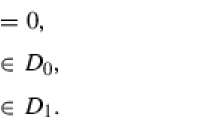Abstract
We consider permutation rational functions (PRFs), V(x)/U(x), where both V(x) and U(x) are polynomials over a finite field \(\mathbb {F}_q\). Permutation rational functions have been the subject of several recent papers. Let M(n, D) denote the maximum number of permutations on n symbols with pairwise Hamming distance D. Computing lower bounds for M(n, D) is the subject of current research with applications in error correcting codes. Using PRFs of specified degrees d we obtain improved lower bounds for\(M(q,q-k)\) for prime powers q and \(k \in \{5,6,7,8,9\}\), and for \(M(q+1,q-k)\) for prime powers q and \(k \in \{4,5,6,7,8,9\}\).
Similar content being viewed by others
References
Bereg S., Levy A., Sudborough I.H.: Constructing permutation arrays from groups. Des. Codes Cryptogr. 86(5), 1095–1111 (2018).
Bereg S., Malouf B., Morales L., Stanley T., Sudborough I.H.: Improved lower bounds for permutation arrays using permutation rational functions. In: Bajard J., Topuzoglu A. (eds.), 8th International Workshop on the Arithmetic of Finite Fields (WAIFI 2020), volume 12542 of Lecture Notes in Computer Science, pp. 234–252. Springer, (2020) https://doi.org/10.1007/978-3-030-68869-1_14.
Bereg S., Malouf B., Morales L., Stanley T., Sudborough I.H., Wong A.: Equivalence relations for computing permutation polynomials. arXiv e-prints, arXiv:1911.12823, (2019).
Bereg S., Miller Z., Mojica L.G., Morales L., Sudborough I.H.: New lower bounds for permutation arrays using contraction. Des. Codes Cryptogr. 87, 2105–2128 (2019).
Bereg S., Mojica L.G., Morales L., Sudborough I.H.: Constructing permutation arrays using partition and extension. Des. Codes Cryptogr. 88(2), 311–339 (2020).
Bereg S., Morales L., Sudborough I.H.: Extending permutation arrays: improving MOLS bounds. Des. Codes Cryptogr. 83(3), 661–683 (2017).
Chu W., Colbourn C.J., Dukes P.: Constructions for permutation codes in powerline communications. Des. Codes Cryptogr. 32(1–3), 51–64 (2004).
Colbourn C.J., Kløve T., Ling A.C.H.: Permutation arrays for powerline communication and mutually orthogonal latin squares. IEEE Trans. Inf. Theory 50(6), 1289–1291 (2004).
de la Torre D.R., Colbourn C.J., Ling A.C.H.: An application of permutation arrays to block ciphers. Cong. Numer. 145, 5–7 (2000).
Ding Z., Zieve M.E.: Low-degree permutation rational functions over finite fields. arXiv: 2010.15657, (2020).
Fan X.: A classification of permutation polynomials of degree 7 over finite fields. Finite Fields Appl. 59, 1–21 (2019).
Fan X.: Permutation polynomials of degree 8 over finite fields of characteristic 2. arXiv e-prints, page arXiv:1903.10309, (2019).
Fan X.: Permutation polynomials of degree 8 over finite fields of odd characteristic. Bull. Aust. Math. Soc. 1–16 (2019).
Ferraguti A., Micheli G.: Full classification of permutation rational functions and complete rational functions of degree 3. Des. Codes Cryptogr. 88, 867–886 (2020).
Ferreira H.C., Vinck A.J.H.: Interference cancellation with permutation trellis codes. IEEE-VTC Fall Veh. Technol. Conf. 2000(5), 2401–2407 (2000).
Gao F., Yang Y., Ge G.: An improvement on the Gilbert-Varshamov bound for permutation codes. IEEE Trans. Inf. Theory 59(5), 3059–3063 (2013).
Guidi F.A., Lindqvist S., Micheli G.: Full orbit sequences in affine spaces via fractional jumps and pseudorandom number generation. Math. Comput. 88(318), 2005–2025 (2019).
Hou X.: Permutation polynomials over finite fields—a survey of recent advances. Finite Fields Appl. 32, 82–119 (2015).
Hou X., Sze C.: On a type of permutation rational functions over finite fields. Finite Fields Appl. 68, 101758 (2020).
Hou X.-D.: Rational functions of degree four that permute the projective line over a finite field. arXiv: 2005.07213v2, (2020).
Huczynska S.: Powerline communication and the 36 officers problem. Philoa. Trans. R. Soc. A 364(1849), 3199–3214 (2006).
Janiszczak I., Lempken W., Östergård P.R.J., Staszewski R.: Permutation codes invariant under isometries. Des. Codes Cryptogr. 75(3), 497–507 (2015).
Janiszczak I., Staszewski R.: Isometry invariant permutation codes and mutually orthogonal latin squares. J. Comb. Des. 27(9), 541–551 (2019).
Li J., Chandler D.B., Xiang Q.: Permutation polynomials of degree 6 or 7 over finite fields of characteristic 2. Finite Fields Appl. 16, 406–419 (2010).
Lidl R., Mullen G.L.: When does a polynomial over a finite field permute the elements of the fields II? Am. Math. Monthly 100(1), 71–74 (1993).
Micheli G., Neri A.: New lower bounds for permutation codes using linear block codes. IEEE Trans. Inf. Theory 66(7), 4019–4025 (2020).
Pavlidou N., Vinck A.H., Yazdani J., Honary B.: Power line communications: state of the art and future trends. IEEE Commun. Mag. 41(4), 34–40 (2003).
Shallue C.J., Wanless I.M.: Permutation polynomials and orthomorphism polynomials of degree six. Finite Fields Appl. 20, 84–92 (2013).
Smith D.H., Montemanni R.: A new table of permutation codes. Des. Codes Cryptogr. 63(2), 241–253 (2012).
Sobhani R., Abdollahi A., Bagherian J., Khatami M.: A note on good permutation codes from Reed-Solomon codes. Des. Codes Cryptogr. 87(10), 2335–2340 (2019).
Vinck A.J.H.: Coded modulation for power line communication. AE Int. J. Electron. Commun. 45–49 (2011).
Wang X., Zhang Y., Yang Y., Ge G.: New bounds of permutation codes under hamming metric and kendall’s \(\tau \) -metric. Des. Codes Cryptogr. 85(3), 533–545 (2017).
Yang L., Chen K., Yuan L.: New constructions of permutation arrays. arXiv e-prints, arXiv:0801.3987v1, (2006).
Author information
Authors and Affiliations
Corresponding author
Additional information
Communicated by C. J. Colbourn.
Publisher's Note
Springer Nature remains neutral with regard to jurisdictional claims in published maps and institutional affiliations.
Research of the first author is supported in part by NSF award CCF-1718994.
Rights and permissions
About this article
Cite this article
Bereg, S., Malouf, B., Morales, L. et al. Using permutation rational functions to obtain permutation arrays with large hamming distance. Des. Codes Cryptogr. 90, 1659–1677 (2022). https://doi.org/10.1007/s10623-022-01039-x
Received:
Revised:
Accepted:
Published:
Issue Date:
DOI: https://doi.org/10.1007/s10623-022-01039-x
Keywords
- Permutation codes
- Permutation arrays
- Hamming distance
- Permutation rational functions
- Permutation polynomials




